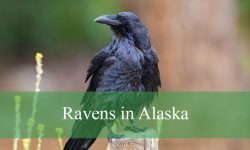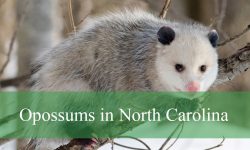Hairy caterpillars come in a variety of captivating forms, each showcasing unique colors and features. The yellow-spotted tussock moth caterpillar, with its bold black and yellow patterns and prominent tufts, contrasts sharply with the pale tussock moth caterpillar’s greenish-yellow body and striking crimson tufts. Meanwhile, the fox moth caterpillar sports a vibrant orange back adorned with black hairs, and the Virginia ctenucha caterpillar displays a creamy white body with vivid red accents.
Above are just a few examples of hairy caterpillar species. To explore 21 more species of hairy caterpillars and their identifying characteristics, please continue reading the article.
Different Types of Hairy Caterpillars
Yellow Woolly Bear Caterpillar
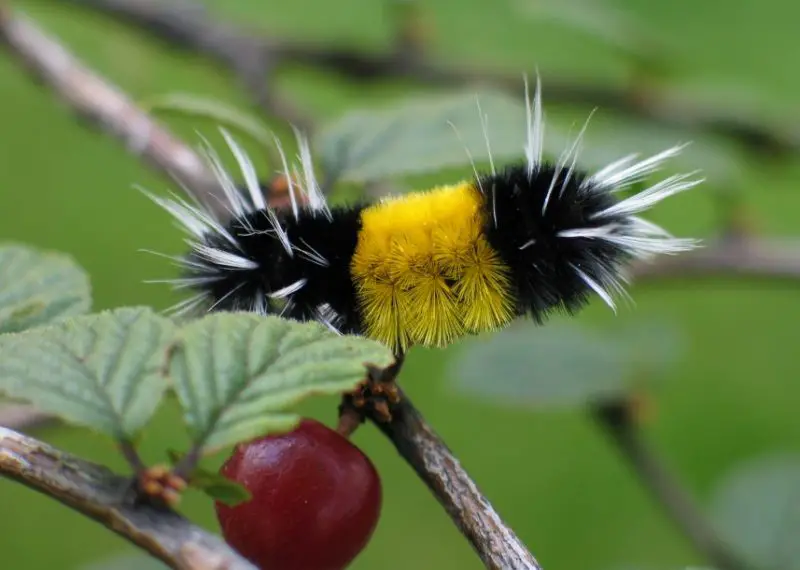
The yellow woolly bear caterpillar (Spilosoma virginica) is named for its bronze-brown tufts that give it a soft, fuzzy appearance. Its woolly hairs can be yellowish-brown, golden-brown, black, orangey-red, or dark yellow, depending on its habitat, and it can grow up to 2 inches (50 mm) long. Though the spiky hairs do not sting or contain venom, they can cause skin irritation if handled without gloves.
The yellow woolly bear caterpillar is identified by its tufts of yellow or orangey-brown hairs covering its brownish-tan body.
Garden Tiger Moth Caterpillar

The garden tiger moth caterpillar (Arctia caja) is adorned with hair-like spines on its black, orange, and gray hairs, resembling a hedgehog or porcupine. Its long black and dark gray spines, though soft in appearance, can irritate the skin if handled. Predators find these caterpillars toxic. Upon transformation, they become striking moths with black, white, and orange wing patterns.
The garden tiger moth caterpillar is easily identified by its black and orange-hairy body, adorned with long grayish spines.
Walnut Caterpillar
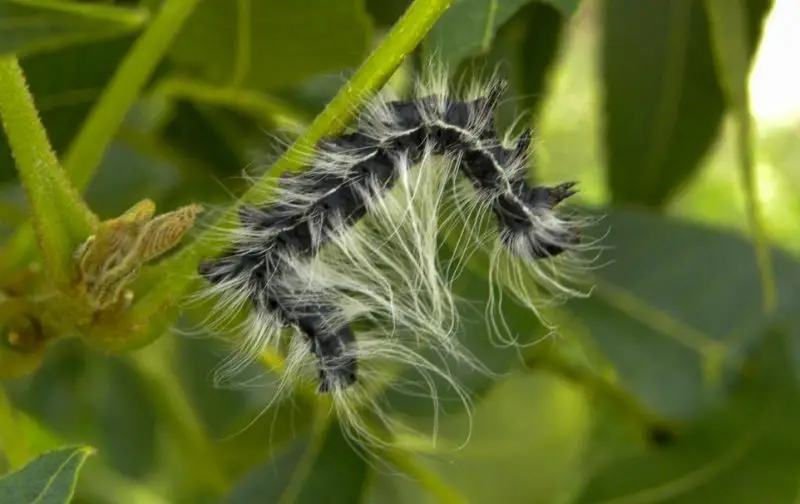
The walnut caterpillar (Datana integerrima) is a hairy black caterpillar adorned with long, whitish-gray, wispy spines. Its cylindrical body reaches up to 1.1 inches (30 mm) in length and is non-irritating to touch, making it safe for humans. These caterpillars are known for their habit of congregating in large groups. They often defoliate pecan, butternut, hickory, and walnut trees, sometimes covering branches with their spindly hairs.
Identifying features of the walnut caterpillar include its slender, worm-like black body covered with thin hairs that lend it a fuzzy appearance.
Monkey Slug Caterpillar
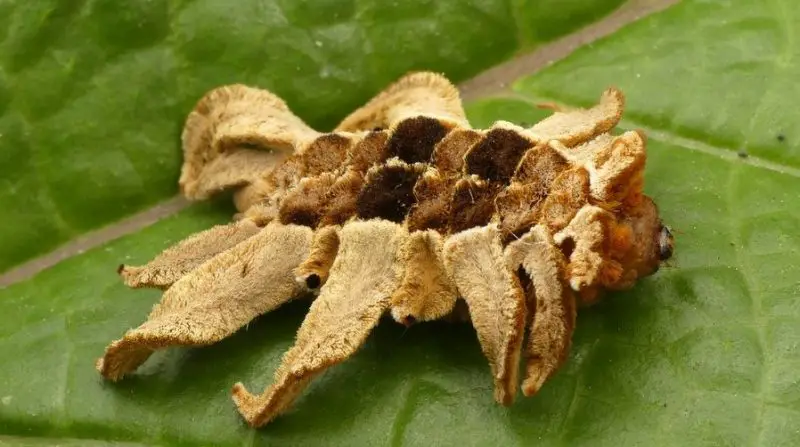
The monkey slug caterpillar (Phobetron pithecium) is notable for its dense covering of hairs, making it one of the hairiest caterpillars. This brown, hairy larva is a unique species, also known as the hag moth caterpillar. Its golden-brown body is flattened, resembling a squashed spider, with 18 curled, hairy projections.
Monkey slug caterpillars typically range from 0.6 to 1 inch (15 to 25 mm) in length. The caterpillar’s black-tan hairs can cause allergic reactions and skin irritation upon contact, highlighting their distinctive and potentially troublesome characteristics.
The monkey slug caterpillar stands out due to its distinctive appearance. With nine pairs of curved, hairy brush-like projections, it is easily recognizable as a shaggy brown caterpillar.
Salt Marsh Moth Caterpillar
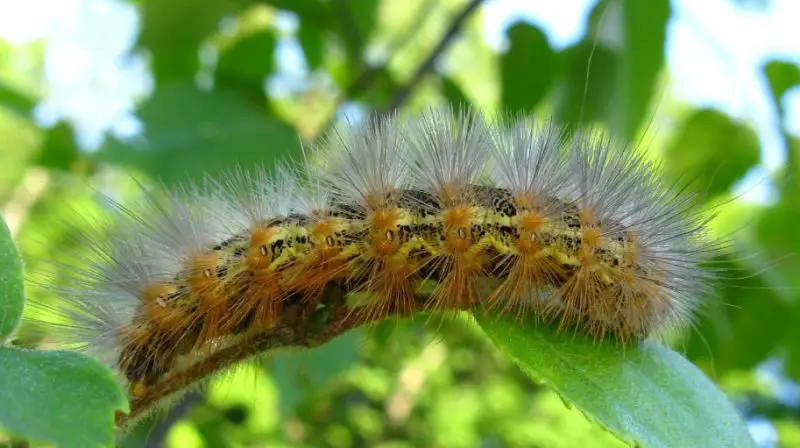
The salt marsh moth caterpillar (Estigmene acrea) is a brown, hairy larva with soft, sharp-looking spines ranging from tan to dark brown. These bristles do not sting but may cause skin irritation. Growing up to 2 inches (50 mm) long, it features a plump, cylindrical body adorned with a row of orange warts and white dots. This caterpillar feeds on soybean, cabbage, cotton, and tomato plants.
Identifiable by its slender, dark brown body with a distinctive row of black or orange spots along its abdomen, the salt marsh caterpillar is commonly found in marshy habitats.
Hickory Tiger Moth Caterpillar
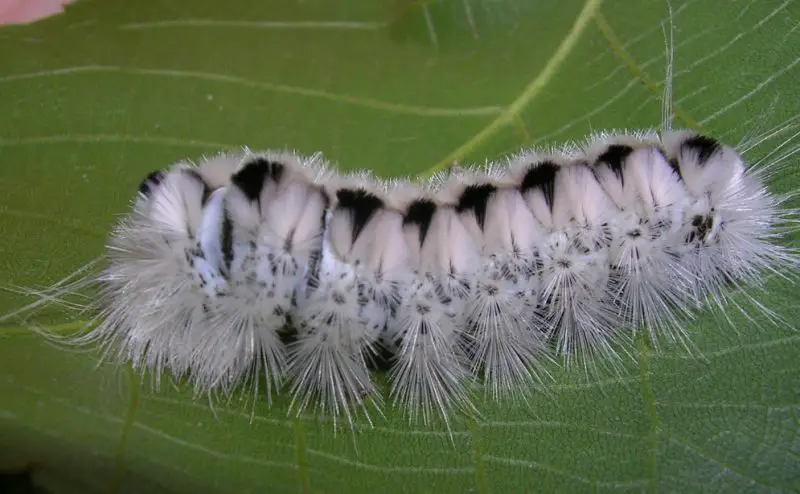
The Hickory Tiger Moth caterpillar (Lophocampa caryae) is identified by its white, hairy body with diamond-shaped black patterns along its back, resembling those of the hickory tussock moth. It has tufts of black hairs and a rounded glossy head typical of tussock caterpillars. These caterpillars grow up to 1.7 inches (45 mm) long and are covered in barbed spines that can cause skin discomfort. They feed on pecan, walnut, hickory, willow, and other deciduous trees.
Recognizable by its white body with tufts of white hair and distinctive black stripes, the hickory tiger moth caterpillar stands out for its striking appearance.
Banded Woolly Bear Caterpillar
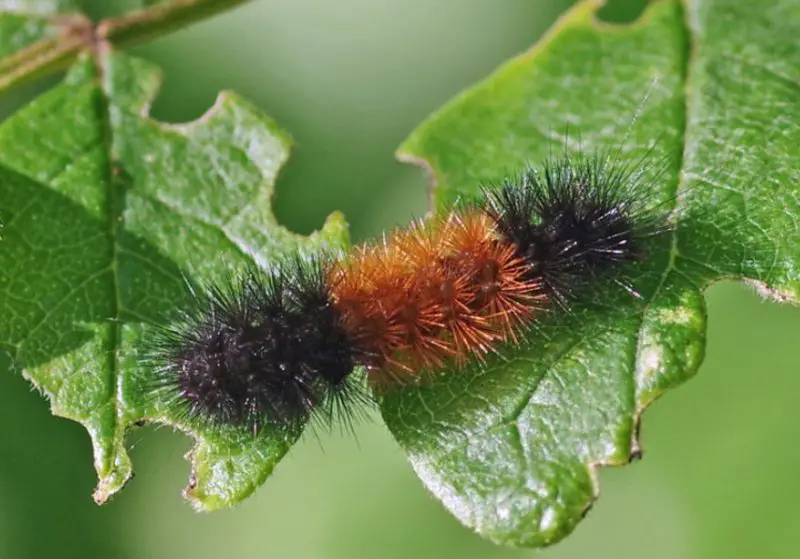
The banded woolly bear caterpillar (Pyrrharctia isabella) is a striking creature covered in black and orange hairs. Its body features a black middle with a wide orange band, and it has six legs, a small black head, and 13 segments hidden beneath its thick coat. Despite its fuzzy appearance, the caterpillar’s spiky hairs can cause skin discomfort and itching.
This caterpillar eventually transforms into the beautiful Isabella tiger moth. Known also as the woolybear or wooly worm, this caterpillar can grow up to 2 inches (50 mm) long and often rolls into a ball when threatened.
Sycamore Tussock Caterpillar
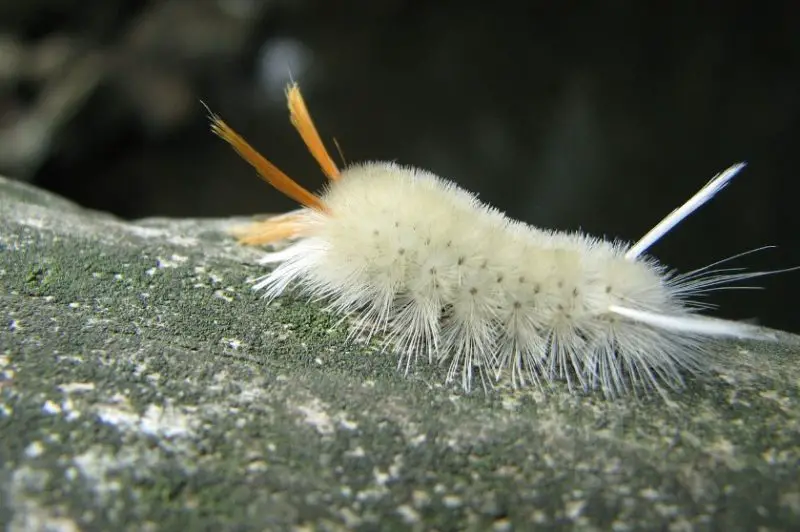
The sycamore tussock caterpillar (Halysidota harrisii) is notable for its distinctive long hairs at both ends, which is unusual for a white hairy caterpillar. Its yellow-orange head and body are covered in white bristly hairs. While it won’t sting, the spiky tufts can irritate your skin if handled.
This caterpillar is commonly found on the American sycamore tree. Identifiable by its hairy white body and two long orange hair tufts at each end, the sycamore tussock caterpillar can grow up to 1.1 inches (30 mm) long.
Banded Tussock Moth Caterpillar
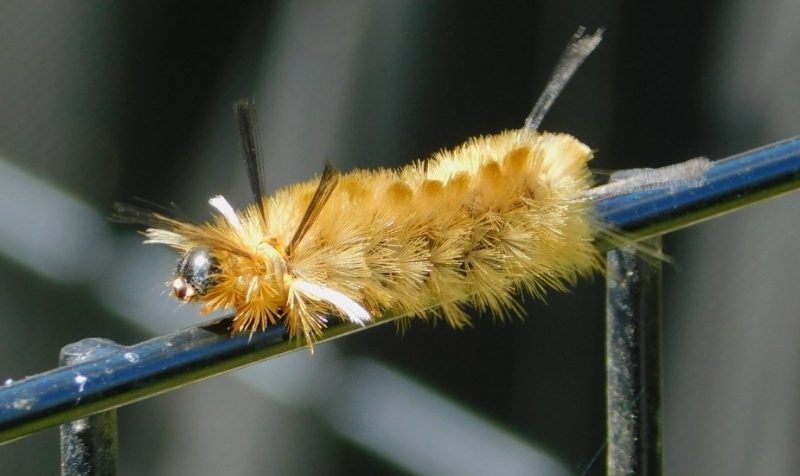
The banded tussock moth caterpillar (Halysidota tessellaris) is a fluffy, grayish caterpillar with long black hair tufts at each end. It has a distinctive black stripe down its back and an orange head hidden beneath its hairs. Found on birch, ash, alder, oak, and willow trees, these caterpillars rarely harm trees or shrubs, despite their leaf-chewing habits.
The caterpillar is identifiable by its six long black lashes and two shorter white tufts. The banded tussock moth caterpillar can grow up to 1.37 inches (35 mm) long.
American Dagger Caterpillar
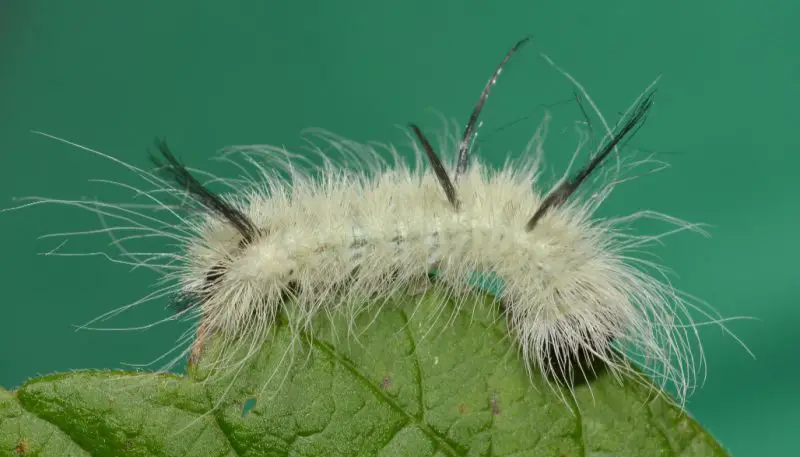
The American dagger caterpillar (Acronicta americana) is easily identified by its yellow-whitish, hairy appearance. It has a shiny black head and two sets of long black tufts on its abdomen. Although non-venomous, its hairy body can cause skin irritation. Handling this caterpillar may feel like being stung, as its irritating hairs can break off and cause itching.
From July to October, these caterpillars are found on oak, birch, elm, and maple leaves. After pupating, the caterpillar transforms into a gray American dagger moth. Notable characteristics include its pale-yellow, shaggy body and pairs of long black setae on its back.
Sycamore Moth
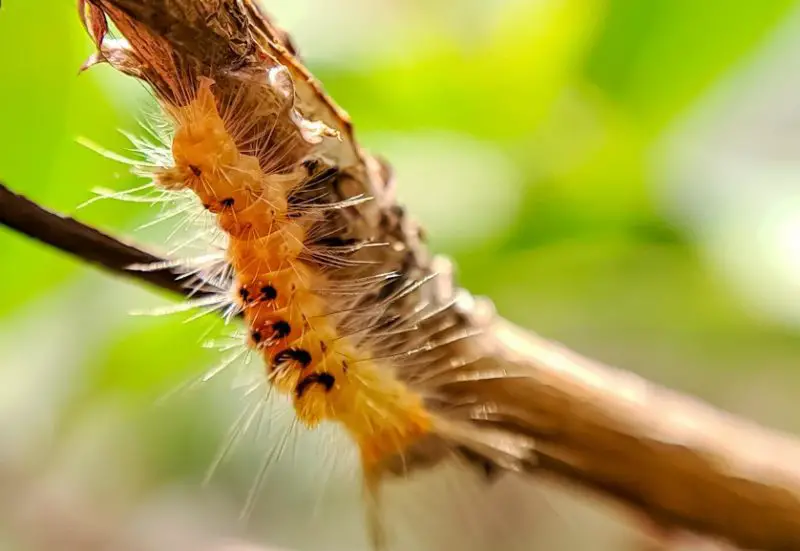
The sycamore moth caterpillar (Acronicta aceris) is a striking yellow caterpillar with brilliant orange tufts and white dots covering its body. It features orange-yellow hairs, a dark head, six prolegs, and a short body. These non-stinging caterpillars, which grow up to 1.5 inches (40 mm) long, are commonly found on sycamore and horse chestnut trees.
Notable identification features include pyramidal tufts of orange-yellow hairs and a row of white dots along its back. Despite its vivid appearance, this caterpillar does not pose a threat to humans or its host trees.
Milkweed Tiger Moth Caterpillar
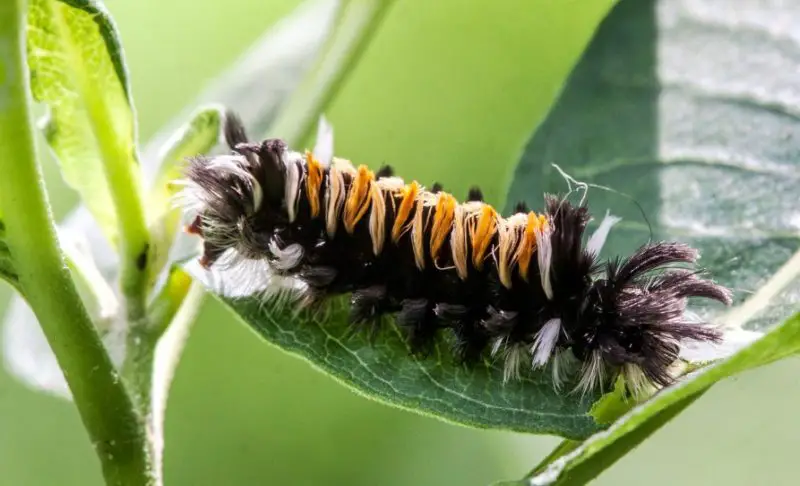
The milkweed tiger moth caterpillar (Euchaetes egle) is a distinctive, hairy caterpillar covered in black, white, and orange tufts. Also known as the milkweed tussock moth, it becomes more orange as it matures. These caterpillars can grow up to 1.3 inches (35 mm) long and are known for skeletonizing leaves, often damaging milkweed and dogbane plants. The chemicals in milkweed sap make these hairy caterpillars poisonous to birds and other predators.
Key identification features include their black, orange, and white tufts. Despite their harmful effects on plants, they play a role in the ecosystem by supporting the life cycle of the milkweed tiger moth.
White-Marked Tussock Caterpillar
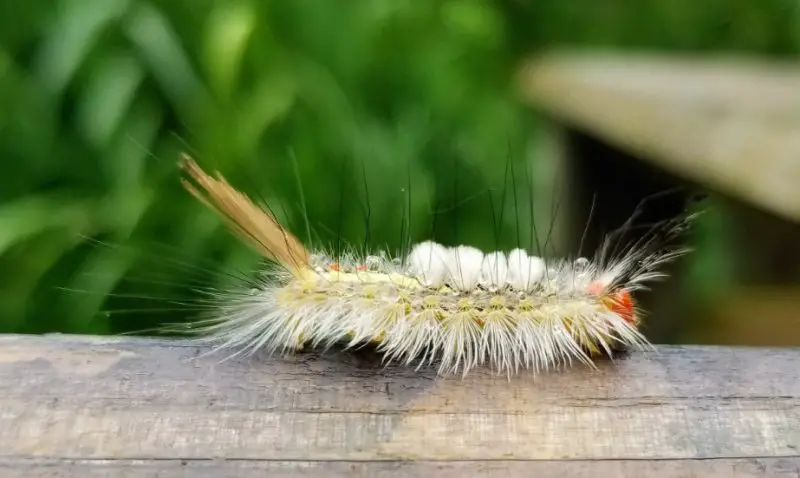
The white-marked tussock caterpillar (Orgyia leucostigma) is easily recognizable by its distinctive appearance. It features four white toothbrush-like tufts on its slender yellow and black body, numerous red dots, and long pencil hairs at both ends. Yellow stripes along its black body are another distinguishing characteristic. Though non-stinging, its spiky tufts can cause a stinging sensation if handled due to small barbs that may embed in the skin.
This unusual-looking caterpillar is widespread in Florida and is often found crawling on various surfaces. Its distinctive features include the four bushy white tufts on its back, yellow stripes, and wispy white and black spines.
Southern Flannel Moth Caterpillar
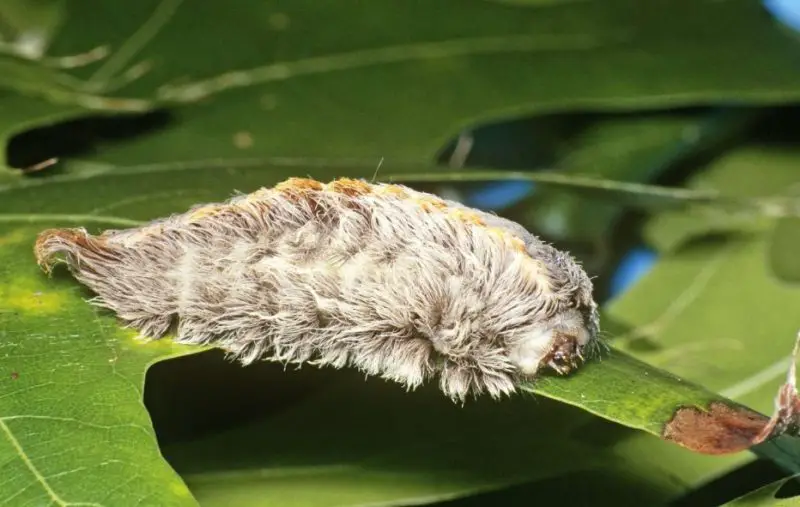
The Southern flannel moth caterpillar (Megalopyge opercularis) is one of the fluffiest caterpillars, featuring light brown hairs that conceal venom-filled spines, giving it a deceptive and potentially harmful appearance. This stinging caterpillar ranges from golden brown to dark gray and can grow up to 1 inch (25 mm) long. It is also known as the puss moth, Italian asp, fire caterpillar, woolly slug, and asp caterpillar due to its delicate, silklike appearance and stinging nature.
The Southern flannel moth caterpillar is easily recognizable by its delicate, disheveled golden-brown hairs.
Virginia Ctenucha
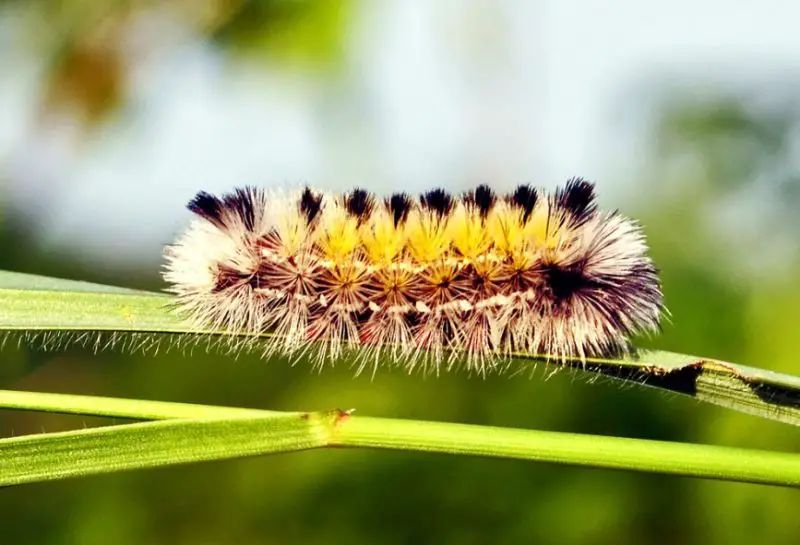
The Virginia Ctenucha caterpillar (Ctenucha virginica) has a creamy white body covered in white and yellow hairs, with a red head and crimson prolegs. It grows between 0.8 and 1 inch (20–25 mm) long and transforms into one of North America’s largest wasp moths after pupation. In some stages, it can also be identified by its black body with a white stripe on each side.
Recognizable by its white and yellow hair tufts, the Virginia ctenucha caterpillar stands out with its unique coloration and markings.
Yellow Spotted Tussock Moth Caterpillar
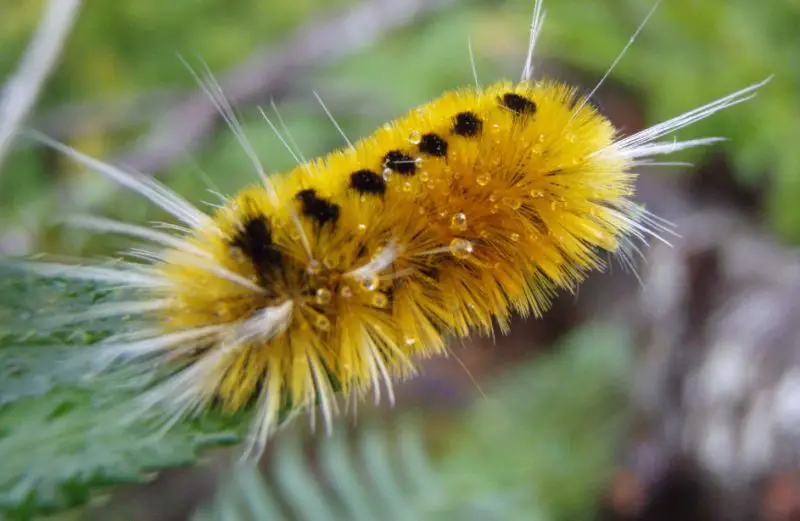
The Yellow Spotted Tussock Moth caterpillar (Lophocampa maculata) stands out with its striking black and yellow coloring and distinctive white hair pencils on its jet-black ends. These caterpillars, often found on shrubs and trees, are also known as yellow woolly bears due to their fuzzy appearance. They grow up to 1.1 inches (30 mm) long and sport hairy yellow and black tussocks.
Identified by its yellow and black hairs with white tufts at both ends, the yellow-spotted tussock moth larva is easily recognizable in its habitat.
Fall Webworm
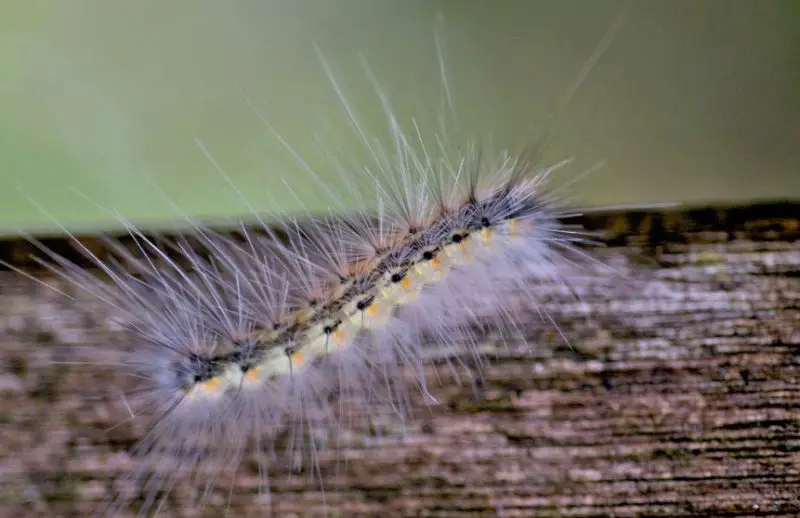
Fall webworms (Hyphantria cunea) are hairy, either white or pale-yellow caterpillars with thin, whitish filaments, known for their destructive habits on shrubs and trees. These caterpillars commonly build tent-like structures where they reside, easily identified by their rounded, glossy black or crimson heads. During autumn, their large nests hang from tree branches, housing the fuzzy white larvae that can grow up to 1.37 inches (35 mm) long. After pupating, these slender, hairy insects transform into beautiful white moths.
The thread-like hairs covering the slender, black, or dark brown bodies of the fall webworm are distinctive features.
Pale Tussock Moth Caterpillar
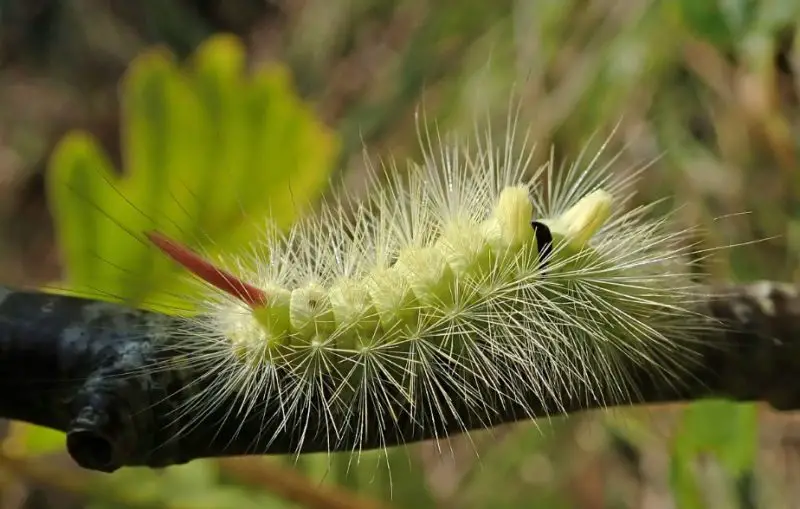
The Pale Tussock Moth caterpillar (Calliteara pudibunda) is a yellowish-green, hairy larva adorned with black stripes along its body, typical of tussock caterpillars. It features tufts along its back, with a prominent crimson tuft of lashes at one end. When it is coiled, its black stripes become visible.
These caterpillars grow between 1.5 and 1.7 inches (40 and 45 mm) long and can exhibit red, light brown, or green coloration depending on their stage. Bright yellow tufts of setae, black stripes, and a projecting tuft of hair pencils at the rear end distinguish the Pale Tussock Moth caterpillar.
Fox Moth Caterpillar
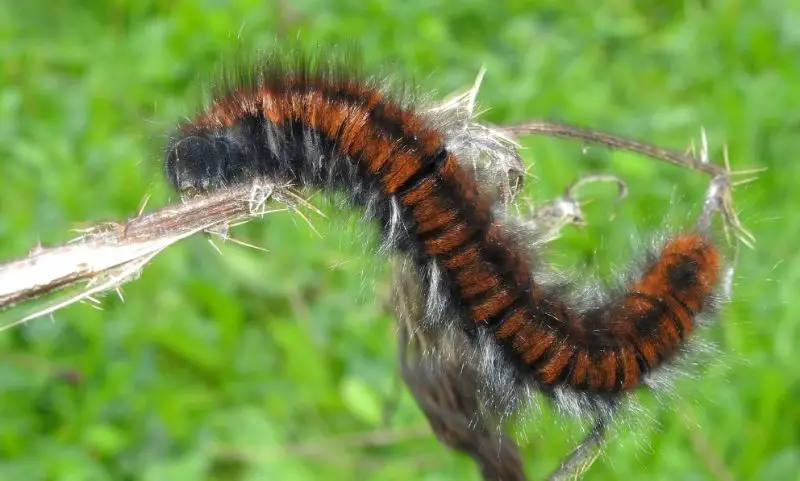
The Fox Moth caterpillar (Macrothylacia rubi) displays a bright orange back adorned with black hairs and orange markings. Growing up to 3 inches (8 cm) long, it features a distinctive black and orange coloration. This caterpillar transforms into a large, fuzzy moth with a beautiful tan color. It feeds on various plants, including shrubs, flowering perennials, birch trees, willows, and beans.
Identified by its hairy black body and vivid orange stripes along its back, the Fox Moth caterpillar is easily recognizable in its environment.

